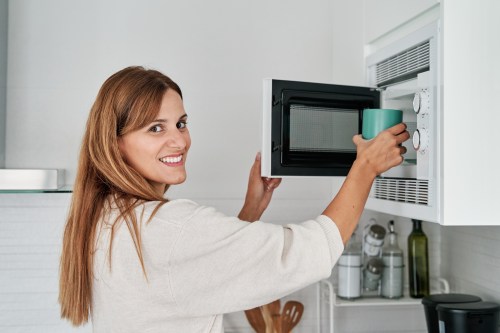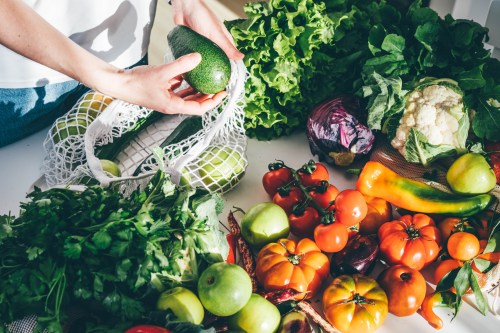Yes, You Can Use Your Blender as a Coffee Grinder (Baristas Agree)
A coffee expert explains how you can easily use your blender as a coffee grinder with these key steps for brewing the perfect cup.

If your favorite mug reads in big, bold letters, “Don’t talk to me until I’ve had my coffee,” you’re speaking to our collective soul. Just like your go-to daily skincare routine and non-negotiable hot girl walk, the morning isn’t complete until you’ve peeled your eyes open and instantly taken care of the first order of business for the day: Glugging an entire cup of cold brew. Aaaaah.
Experts in This Article
coffee expert and co-owner and founder of Bean &
TBH, whether or not you’ve had your coffee can be the deciding factor between existing as Oscar the Grouch or Elmo for the day. And although there’s nothing wrong with a drive-thru cup of joe, Jiyoon Han, co-owner and founder of Bean & Bean, a New York-based, AAPI family-owned coffee company, says that using freshly ground, high-quality beans is key to achieving coffee nirvana.
Before you open the Amazon app to order a pricy burr coffee grinder and add yet another appliance to your heaping collection of kitchen gadgets, Han says that you can easily transform your blender into a coffee grinder in seconds. Although this genius trick yields solid results, Han explains that there are a few key steps and considerations to grinding coffee beans in a blender that can give you the best-quality cup. Here’s everything you need to know.
How to grind coffee beans using a blender, according to a coffee expert
Although Han would love for everyone to have access to proper coffee-making equipment, she says it’s most definitely not a necessity. “As a roaster, we have to relinquish any sort of judgment because coffee is highly contextual. My goal is to meet the customer where they’re at, without forcing them or pushing them where they don’t want to be at that moment in time,” she says.
Instead, there are a few simple tricks to making a great cup of coffee with what you’ve got. “Most people don’t have a burr grinder, but there are different ways in which you can brew a good cup despite that,” Han says. “When I’m in my own kitchen, I have everything I need and want. However, when I go to my grandmother’s house in the countryside in Korea, she doesn’t have all of these things. She doesn’t have a burr grinder, so I do what I can with what I have.”
At her grandmother’s home, Han uses a small, hand-held, two-blade spice blender to get the job done, and adds that you can use your standard full-size blender in the same way. The key, she says, is to work in small batches and pulse the blender in short increments to avoid overheating the product. Between blending intervals, Han makes sure to give the coffee a shake to redistribute the granules to achieve the most consistent texture possible. And if you end up with a few larger particles, all you need to do is pass the coffee through a sieve. (She simply regrinds these larger pieces again to achieve a finer consistency and avoid wasting any precious beans.)
Although the burr grinders will achieve the best and most uniform texture as quickly and efficiently as possible, Han says that blender-ground coffee beans definitely do the trick—especially for a few specific brewing methods and beans. She says that French press or cold brew immersion methods and medium and dark roasts will be the most forgiving combinations in terms of taste if your grinds aren’t exactly super consistent in size and shape.
P.S. Han says never to store your coffee grounds in the refrigerator; it’s a natural deodorizer and will absorb any and all smells, including last night’s leftovers.
The five key steps to making the *perfect* cup of coffee just like a professional barista
Use high-quality, fresh coffee beans. No matter how evenly-ground your beans are, you’ll never make a truly delicious tasting mug using ancient and/or low-grade coffee beans.
Enlist a burr grinder (or blender, of course). Use a coffee grinder or blender to grind coffee to the right consistency, which depends on the brewing method. Han says you’ll want super-fine coffee grinds, like table salt or sugar for espresso, medium-ground for pour-over or drip, and coarse for French press or cold brew.
Stick to a pour-over method. To brew the coffee, Han suggests using a pour-over device like a Kalita Wave, Chemex, or V60. Han also says to soak the filter in clean water before using it to remove any paper-like residual taste.
Keep a scale handy. According to Han, this helps track how much coffee you’re using and achieve a well-balanced beverage. “You’ll want to brew at a one to 15 ratio, one being coffee and 15 water,” she says.
Temperature-controlled kettle. “The water should be set at 195 to 205 degrees Fahrenheit. This is something I manipulate depending on much coffee there is, but this is the general range,” Han says.
Consider this a dietitian’s love letter to coffee:
Sign Up for Our Daily Newsletter
Get all the latest in wellness, trends, food, fitness, beauty, and more delivered right to your inbox.
Got it, you've been added to our email list.










